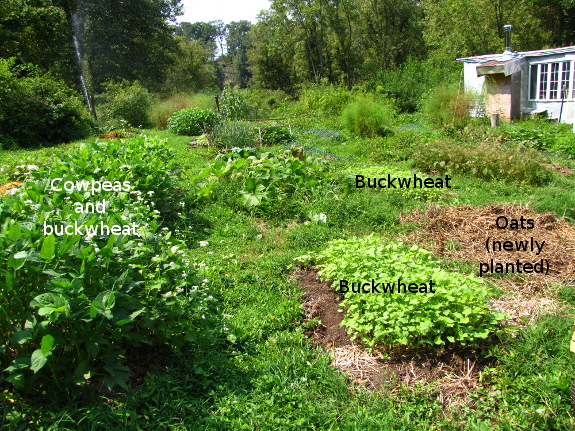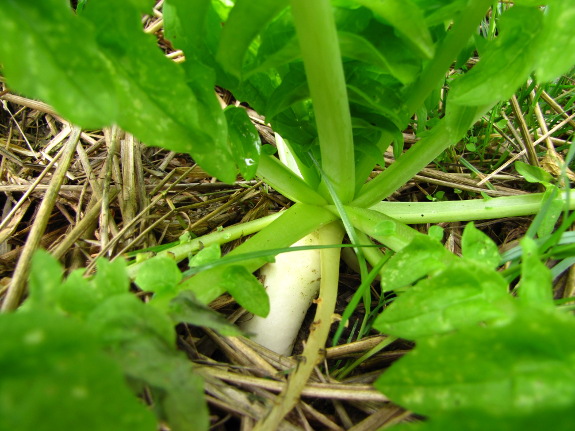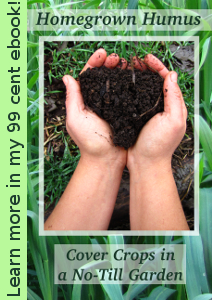
Fitting cover crops into the garden ecosystem

Even if you allot
absolutely no extra growing area to cover crops,
chances are you can slide them into gaps and grow an appreciable amount
of organic matter. I didn't expand my garden after
learning about cover crops, but I soon found I could fit buckwheat
into
summer gaps and oats and oilseed radishes into winter gaps without
taking away space from my vegetables. In fact, as organic matter
levels increased in my garden beds, I realized I was getting higher
yields from the plots in vegetable production, and was able to cut back
my planting area and grow more cover crops. The cycle of
soil improvement continues.
In your own garden, I
recommend starting small until you learn the
intricacies of each cover-crop species you're using. Once you
settle on a few species that work for you, you'll become adept at
keeping
an eye out for garden areas going to waste. Did your cucumbers
succumb to blight a month before you'd planned to pull them out and
seed fall carrots? A perfect opportunity for a round of
buckwheat! Is a bed of green beans eaten up by potato
beetles? Go ahead and pull it out and plant some oilseed radishes
for winter biomass accumulation.

As you add cover crops
to your planting cycle, you'll probably begin to see improvements in
your garden ecosystem that
far exceed the effects of organic matter accumulation. I've
noticed that spring seedlings seem to be healthier in beds that have
grown oats or oilseed radishes over the winter than in beds that have
simply been mulched with straw. Perhaps the reason is that the
living soil web—microorganisms that feed on the sugars put off by plant
roots and, in return, provide micronutrients to the plants—is heartier
in
beds where something has been green and growing recently. Or
maybe the effect is the result of sulfur-related compounds emitted by
radishes that kill nematodes and other bad microorganisms in the
soil. The increase in pollinators around the farm as a result of
buckwheat flowers is easier to decipher, but who knows how many other
relationships like this are active in the garden ecosystem while being
invisible to our untrained eyes?

 As much as I've enjoyed my
cover crop journey over the last few years,
I'm sure I still have a lot to learn. Are there cover crops
chickens will enjoy even more than oilseed radishes? Can I close
the homestead fertility loop by growing my own straw and compost in
addition to using my current, simple methods of increasing organic
matter right in
the garden beds?
As much as I've enjoyed my
cover crop journey over the last few years,
I'm sure I still have a lot to learn. Are there cover crops
chickens will enjoy even more than oilseed radishes? Can I close
the homestead fertility loop by growing my own straw and compost in
addition to using my current, simple methods of increasing organic
matter right in
the garden beds?
Homegrown
Humus sums up my
experiences to date, but I'm sure there's more to learn. Download
the ebook free on Amazon today (or email
me for a free pdf
copy), then send me updates on your own cover crop experiments.
I'm looking forward to updating this draft with many more cover crop
adventures in years to come.
| This post is part of our Homegrown Humus lunchtime series.
Read all of the entries: |
Want more in-depth information? Browse through our books.
Or explore more posts by date or by subject.
About us: Anna Hess and Mark Hamilton spent over a decade living self-sufficiently in the mountains of Virginia before moving north to start over from scratch in the foothills of Ohio. They've experimented with permaculture, no-till gardening, trailersteading, home-based microbusinesses and much more, writing about their adventures in both blogs and books.
Want to be notified when new comments are posted on this page? Click on the RSS button after you add a comment to subscribe to the comment feed, or simply check the box beside "email replies to me" while writing your comment.

Today is the first time I have had a chance to get back to your awesome site. Thank you for the kind thought of fitting me in to the free period, even though I never contacted you about it. I am a teacher at small private school where we all teach a little bit of everything and the end of January was the end of our first semester. It was also the day the other full-time teacher and I realized that several of our seniors need electives credits and both of us would need to create a class for the next semester that started in less than a week. My new class has kept me CRAZY BUSY!! My husband teases that I have been going through withdrawal symptoms from your blogs. Thank goodness for Spring Break
Thank you again, April